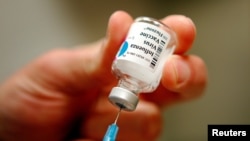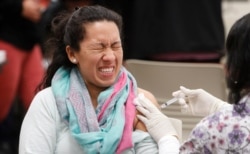As if the COVID-19 pandemic isn't bad enough, flu season is about to begin in the Northern Hemisphere, adding millions of illnesses, hundreds of thousands of hospitalizations and tens of thousands of deaths to the already-strained American health care system.
"We really, really want to emphasize the potential for disaster, actually," said Jeanne Marrazzo, director of the Division of Infectious Diseases at the University of Alabama at Birmingham and a member of the Infectious Diseases Society of America board of directors, at a recent briefing for reporters.
Experts are urging everyone to get flu shots in order to take some of the load off of health workers and hospitals.
Each year, the Centers for Disease Control and Prevention (CDC) estimates, up to 61,000 people die from influenza in the United States and as many as 810,000 are hospitalized.
Meanwhile, nearly 200,000 Americans have died so far from COVID-19, the disease the coronavirus causes, according to the Johns Hopkins University Coronavirus Resource Center. The virus is killing about 800 Americans per day on average, according to the CDC, a figure that has hardly changed for weeks.
"We still are on what we think of as a razor's edge with regard to COVID," Marrazzo said.
As fall approaches, "I expect it to get worse," said Michael Mina, assistant professor of epidemiology at Harvard T. H. Chan School of Public Health.
Rates of many respiratory diseases, including colds and flu, increase in the fall and winter. The reasons are not entirely clear but the viruses that cause the diseases may spread more easily in colder, drier air than in warmer, more humid weather. People spend less time outside and more time in close quarters indoors, breathing the same air. Children in school may pass around viruses more readily than when they are home for the summer spending time outside.
It's not clear how much the weather affects the spread of the COVID-19 virus. It's a question scientists are actively studying.
But the coronavirus is related to other viruses that cause the common cold, and "what we see with those viruses is that come October, November, December they skyrocket," Mina said.
"I hope that for some reason this virus behaves differently, but I don't anticipate that it will," he added.
Get your flu shot
While a safe coronavirus vaccine is still months away, health officials are urging everyone to get a flu shot.
In most years, not even half of all U.S. adults get vaccinated, a rate that is even lower among minority groups.
That's in part because getting a shot does not guarantee you won't get the flu.
"Influenza vaccine in a good year is generally between 40 and 60 percent effective," said Walter Orenstein, associate director of the Emory University Vaccine Center. "Not perfect, but it's a lot better than zero percent effective, which is (what you get) if you don't get vaccinated."
The vaccine helps, even if it does not stop the infection, noted Vanderbilt University infectious diseases professor William Schaffner.
"Even if you get influenza after you've had the vaccine, that illness is likely to be less severe," he said. "You're less likely to need to go to the emergency room, less likely to be hospitalized, less likely to die."
That's good for patients, and it's also good for the health care system.
"The last thing we need is a huge surge of flu cases now," he added.
Manufacturers are expecting to produce a record supply of nearly 200 million doses this year.
However, the conditions making flu shots so important are the same conditions that make them harder to distribute, Schaffner noted.
Fewer people will get flu shots at work because more people are working from home. Many public health clinics are closed or reassigned to handle COVID-19. Many people are avoiding doctor's offices out of fear of contracting the virus there.
Pharmacies, grocery stores and other venues are still good options, noted IDSA's Marrazzo. "People will probably need to be perhaps a little bit more creative," she said.
Luckily, the steps taken to limit the spread of the coronavirus, including masks, hand washing and social distancing, also seem to work against the flu. Influenza rates fell by two-thirds in China when COVID-19 lockdowns and restrictions went into place, according to a new study. The World Health Organization (WHO) says these measures have likely played a role in the milder-than-expected flu season currently winding down in the Southern Hemisphere.
"But we really can't be complacent about this," Marrazzo said. "If there was ever a year that you need to get your flu vaccine, and get your kids vaccinated, this is the year."









